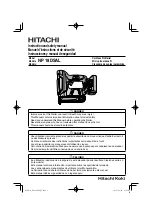
MAINTENANCE
WARNING
: Disconnect tool from air supply and empty fasteners from the magazine before performing
any cleaning or maintenance.
LUBRICATION
Routine lubrication of the tool is required for best performance. An automatic in-line oiler is recommended. If tool
is used without an in-line oiler, place 2 drops of pneumatic tool oil into the air inlet of the tool at the beginning of
each workday or after about 1 hour of continuous use. Oil added through the air inlet will lubricate the internal
moving parts.
CLEANING
Keep the tool clean for better and safer performance. Wipe the tool clean with a damp towel and some soft soap.
Blow the tool clean using compressed air. Only use non-flammable cleaning solutions to wipe exterior of the tool if
necessary. CAUTION: Do not soak tool with cleaning solutions. Such solutions can damage internal parts.
INSPECTION
1. Inspect the trigger and safety mechanism to assure the system is complete and functional (no loose or missing
parts, no binding or sticking parts). Do not operate if any portion of the tool, trigger, or safety bracket is damaged,
inoperable, disconnected, or altered. Any issues with the tool such as leaking air, damaged parts, or missing parts
should be repaired or replaced before use.
2. Inspect the tool and make sure all screws are tight. Loose screws can cause personal injury or damage the tool.
3. All compressed air contains moisture and other contaminates that are detrimental to internal components of the
tool. Dirt and water in the air supply are major causes of pneumatic tool wear. Regularly drain water and contami-
nations out from the compressor. An air line filter is recommended to remove most of these contaminates and
prolong the life of the tool.
Follow the compressor instructions to check the filter of the air compressor.
STORAGE
Place the tool and accessories inside the blow mold case to protect it from dust and moisture. Store the unit and
accessories in a dark, dry, frost-free and well ventilated place, out of the reach of children. The ideal storage tem-
perature is between 50 to 86°F (10 and 30°C).
PRODUCT DISPOSAL
Used pneumatic tools contain recyclable materials and should not be disposed with household waste. Please take
this product to your local recycling facility for responsible disposal and to minimize its environmental impact.
13
Summary of Contents for 61764
Page 14: ...EXPLODED VIEW AND PARTS LIST 14...
Page 18: ...THANKS FOR REMEMBERING...
































